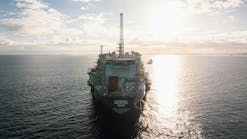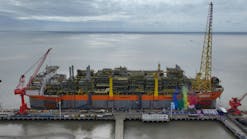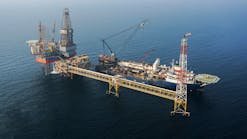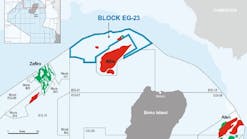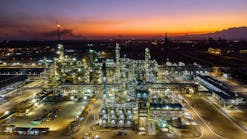Fast-track development of the Mobil field an under budget, on time success story
Rick Von FlaternDespite a 10,000 b/d test of the discovery well, Mobil's Zafiro Field offshore West Africa would seem at first glance a poor candidate for fast-track oil field development. The owner of the concession, tiny Equatorial Guinea, though surrounded by the increasingly developed, oil producing nations of Nigeria, Cameroon, and Gabon, offered no infrastructure of its own to support an offshore oil industry. And the March 1993 discovery and subsequent delineation well revealed little about the reservoir.
Technology Editor
"There were a lot of questions at that point in time," Art Green, general manager of Equatorial Guinea Mobil said. "The options were to do a lot more appraisal-type drilling and scenario analysis or just devise a lower risk, limited investment type of approach to produce some oil and get some answers before we get into any more significant investments."
Mobil opted for the latter, a fast-track development plan, and within 18 months of the discovery well test the field came on line with more than 7,000 b/d flowing to the floating, production, storage and offloading (FPSO) vessel, the Zafiro Producer. By the end of August five wells were producing and by the end of September, seven. By the end of 1996 the field's full compliment of eight subsea wells are slated to be delivering 40,000 b/d of oil.
Mobil project managers attribute quick success at Zafiro to a few method-defining decisions taken early in the projects planning stages to: eliminate traditional borders between geoscience and engineering disciplines; avoid upper level micromanagement while supplying needed risk money; establish short lines of communication; use vendor talent; and make good first time decisions to eliminate time-consuming reworks. "Basically senior managers just laid out the challenge and said 'guys can you do this,'" said Chuck Alexander, Equatorial Guinea project manager for Mobil. "The key was a cross-sectional team of exploration and drilling and everyone talking about what could be done."
Fast-track development at Zafiro often took the form of unusual parallel work schedules and dialogs between explorationists on one end of the spectrum, facilities personnel on the other, or any combination in between. Eclectic input was necessary to make such crucial decisions as well locations and well paths designed to optimize production while accommodating flowline "corridors" placed with drilling and workover rig moorings in mind. "Flexibility and simplicity were the watch words," Green said. "It was drilling tying in between geology and facilities."
The team drilled, tested, and temporarily abandoned four wells by June 1996. The four, the Zafiro 1, 2, and 3 and the Opalo 1 were delineation wells. Using the results of the first four well tests, and aware there was still much they did not know about the reservoir, the team chose four more subsea locations in the belief that eight wells would suffice for the development's first phase goal of defining the reservoir and product characteristics.
Green believes the short project time frame may have actually contributed to its success by creating an environment that quashed interdepartmental friction. "A geologist can easily see that if he doesn't pick a location then we can't buy the pipeline and everyone knew the tight time frame," he said. "[A decision] may not be perfect but you have to make it. If we had three years there might have been more friction."
Floating processing facilities
To produce the Zafiro Field to a floating production, storage, and offloading (FPSO) vessel was not a difficult choice. The Zafiro Field is a remote frontier with no pipeline system in place and as the development was in essence an extended production test, the flexibility inherent in an FPSO was mandatory. Likewise, the decision to convert a tanker to an FPSO rather than purchase one of several on the market was made easy by a company dictum to export oil in million bbl packages that created a storage requirement beyond the capacity of any vessel on the market at the time.
At the end of November 1995, a contract was awarded to Oceaneering International to convert the very large crude carrier, the M/T Swift, to an FPSO. To meet Mobil's ambitious time frame, Oceaneering worked the equivalent of 120 man years in the six-months it took to finish the job. Conversion included life-extension repairs and refurbishment; fabrication and installation of an 80,000 b/d production process system, a 12-point spread mooring system, port and starboard riser porches, helideck, oil offloading system; and a 250-ft retractable flare boom. The vessel also had to be reclassified as an ABS A1 floating production system.
An added attraction for a floater off the coast of Equatorial Guinea was the benign, predictable currents and winds in the area that facilitated spread mooring (anchoring fore and aft) and the use of port and starboard riser porches. So configured, an FPSO can easily accommodate additional risers should more wells than originally planned for be needed. Also, in the event the field was less prolific than expected the FPSO, owned and operated by Oceaneering and on a three-year lease to Mobil, could be removed to another site.
Flowlines, umbilicals, and subsea trees
Immediately on the heels of Mobil's decision to acquire an FPSO was the challenge to configure the flowlines to it in the environment of uncertainty that still characterized the project. The Mobil response was pairs of wells on a flexible, 6-in., looped flowline. In the instance of flowlines, the need for flexibility was literal. "We had to make flowline twists and turns to allow for mooring of rigs over wells," Alexander said. "We came to this arrangement as the result of an iterative process and chose flexible Coflexip pipe because we could fine tune it more easily. We bid it both ways and the flexpipe was competitive."
While each well has a dedicated flowline to the FPSO, a normally-closed connecting line between pairs of wells was added that when opened formed a continuous pigging loop from the FPSO and through pair's flowlines. The inclusion of pigging capability was another Mobil concession to flexibility since at the time, and still, there is no conclusive evidence that line plugging will be a consideration.
So that flowlines and umbilicals could be placed on the seafloor even at the three subsea locations yet to be fitted with a tree, they were run from the FPSO to in line "sleds" placed near the proposed subsea location. Upon installation of the tree, 4-in. jumpers are extended from the sled to the tree by remotely operated vehicles. As is necessary in the event of the final three wells being completed after flowline installation, the drilling rig is used to connect sled to tree. Consequently production was able to begin in August 1996 from completed wells without interference from work being done on the remainder of the eight wells.
Mobil project leaders claim consistent and timely performances of Zafiro contractors and suppliers a critical factor in the overall success of the fast-track development plan. For example, FMC received subsea tree orders in August and were delivering them by the following February. That six-month turn around compares with as many 22 months for other comparable projects.
Mobil also aided its own cause, tapping the subsea tree design and manufacturing experience of its Gulf Coast division in New Orleans so that by the time it put the trees out for bid it had a nearly-complete picture of its needs. The company then added a quality control ingredient that resulted in a non-conformist report rate of 19, compared to some in similar circumstances around the industry that have been as high as 69.
"We did indeed mobilize the talents of the contractors to do what they are best at - their own technologies," Alexander said. "The trick was to knit them together effectively to end up with a system that fit together and to do it within the time frame."
Logistics on the frontier
Just as a short time frame may have helped eliminate friction between project subgroups, ironically the lack of any infrastructure in Equatorial Guinea may have made logistics planning easier. "Everyone understood going in there was no infrastructure," Green said. "We knew what we didn't have so we didn't go in thinking we could get some things there and then be disappointed."
As in any frontier where everything and everyone is coming from somewhere else, logistics at Zafiro was crucial. FMC manufactured and shipped all the subsea trees from Houston. Multiflex sent seven 250-ton reels of umbilicals also from Houston. Coflexip sent all the flexible pipeline from France. Except for some drilling personnel already in Equatorial Guinea, Mobil personnel making decisions and coordinating their own staff, contractors, and suppliers, were in Dallas.
A logistical hurdle engendered by the inevitable need to bring all the parts into a whole was tackled early in the project planning. Drilling rigs and the FPSO had to be moored and flowlines laid. "We recognized early on that there would be at least three major contractors putting things on the seabed that were going to have to fit together," Alexander said. "At the end of the day the riser has to hit the ship within the design limit of the riser. And if you don't do it all properly the flowlines are at risk."
Recognizing the need for a single guide for this seabed traffic, Mobil insisted all contractors use one positioning contractor. What evolved was an exercise Mobil staffers called "the dance," between drilling rigs over the same wells to which lay barges were simultaneously laying flowlines. As each piece of equipment demanded its own significant dayrate, it was the object of the dance, performed daily to steps called by Dallas, to prevent each unit from interfering with the other while performing its own task.
"We had to work it out with a drilling rig with its uncertainties of schedule, and there is always gains and losses in any offshore schedule, and we pretty well managed it - nothing sat around," Green said. "It was remarkable actually because we had accepted the fact that something would be sitting around for a few days and it never happened." The dance became so precisely choreographed that in its final moments the two participants came within an hour of each other - a near miss in a year-long encounter.
Governments and borders
Essential to a smoothly run frontier area project, particularly on a concession in a country not well versed in oil and gas exploration and production, is government cooperation. Equatorial Guinea has been a willing partner in the Zafiro project, according to Green, whose posting to the country affords him constant contact with his official hosts. "The government's and our interests are aligned," he said. "And they are anxious for cash flow and have their own applications for it. It is a third world country and we are doing things that have never been done there before. Big problems no - cooperation yes."
But political uncertainties are endemic to emerging industrial areas like West Africa. Ill-defined borders, particularly when extended into territorial waters, gain a new significance with the discovery of substantial hydrocarbon deposits. Large, multinational oil companies, long accustomed to international exploration and the accompanying, sometimes massive, financial risks, are familiar with such pitfalls. Recent reports from Nigeria indicate that country's challenge to Equatorial Guinea's borders include claims the Zafiro Field is draining reserves belonging to it on a concession it has granted to Elf. Mobil spokespersons have said they are awaiting a third party decision on the matter but do not believe the disputed areas will affect development of Zafiro.
For now the Zafiro Field is on test. Eight wells are expected to produce 40,000 b/d of oil by the end of 1996. If eight are enough or too many will be decided while Mobil takes a development hiatus and gathers data.
Copyright 1996 Offshore. All Rights Reserved.
